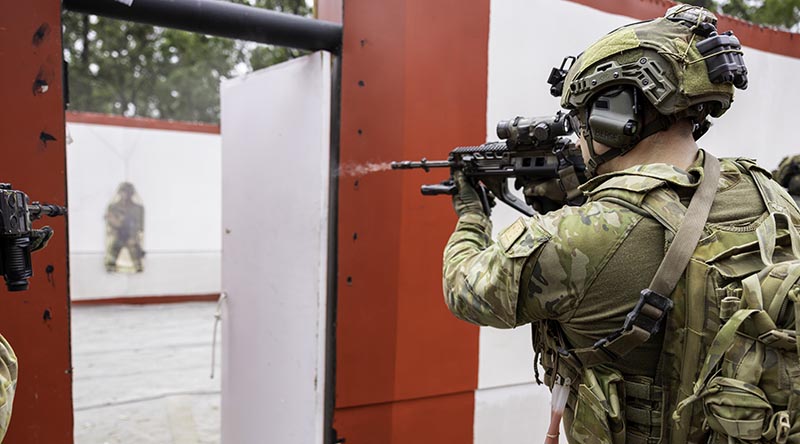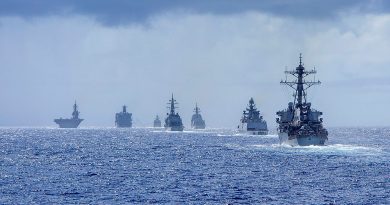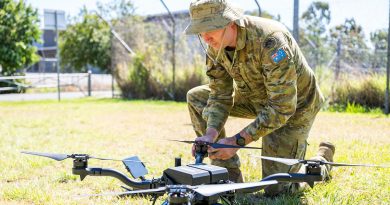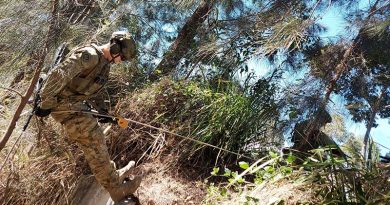Army tests live-fire urban shoot-house

For the first time, infantry soldiers will have access to a purpose-made urban operations live-fire range, after operational testing and evaluation of a prototype facility finished in Brisbane last month.
CAPTION: Australian Army soldiers form the 6th Battalion, Royal Australian Regiment conduct urban live-fire training at Greenbank Training Area. Story by Corporal Jacob Joseph. Photo by Corporal Dustin Anderson.
About 30 soldiers from 8th/9th Battalion, the Royal Australian Regiment (8/9RAR) were the first to live-fire in the newly constructed deployable austere shoot house (DASH) on March 22, designed for training with rifle and pistol.
DASH is a first for conventional Army and the latest urban live-fire range since the 90s and early 2000s, when special operations counter-terrorism facilities were built in Perth and Sydney.
The single-storey complex has 10 rooms and three hallways, configured to test most urban tactics, techniques and procedures.
Walls are constructed from Hesco baskets (defensive barriers), wrapped in rubber sheets and filled with 10mm basalt aggregate, so soldiers can fire as close as one metre away.
Two revamped urban operations courses were recently run by 8/9RAR to prepare soldiers and range staff to conduct live-fire training.
Serials included the use of non-lethal and lethal ammunition in opposed and unopposed scenarios.
Course instructor Warrant Officer Class Two Phil Brown, from the 8/9RAR Combat Cell, said opposed scenarios, incorporating non-lethal training ammunition, explosive breaching and sim grenades was considered the “high watermark” for training.
“The end state of the course is to prepare for war, not a live-fire range,” Warrant Officer Brown said.
“Live-fire is just one of the mediums used to validate individual and collective tactics, techniques and procedures.”
Soldiers preferred non-lethal opposed scenarios as it replicated elements of combat conditions.
Sergeant Casey Morrison, another combat cell instructor, said although live-fire was crucial for training progression, soldiers said it was ‘benign’ compared to opposed scenarios, where they learned to control stress and anxiety.
Doctrine and procedures were developed over the past three years by Warrant Officer Brown, Sergeant Morrison and Corporals Nigel Tegg and Cameron Cherrett based on their experiences conducting urban live-fire, up to platoon level, with Special Operations Command.
Sergeant Morrison said one of the key concepts to emerge was abandoning the perfect solution for a principles-based approach that could be adapted to solve different problems.
“If our participants are using these principles in a combat context, not only do they make us more lethal and survivable but they also aid range safety, controlling a live-fire manoeuvre practice.”
It represents a new approach to urban training, according to course instructors, who said a lot of work was needed to reshape soldiers’ perceptions from “kicking in doors and rushing in” to being deliberate and methodical.
“There’s so much in this space to learn,” Sergeant Morrison said.
“Every soldier needs to start this journey from when they reach Singleton or even Kapooka.
“It’s a skill that degrades quickly and takes a lot of practice to maintain – reading building anatomy and other combatants’ body language and manoeuvring as a team in a complex environment effectively.”
When testing wraps up, DASH is expected to roll out to combat brigades within the next three years.
.
.

.
.





